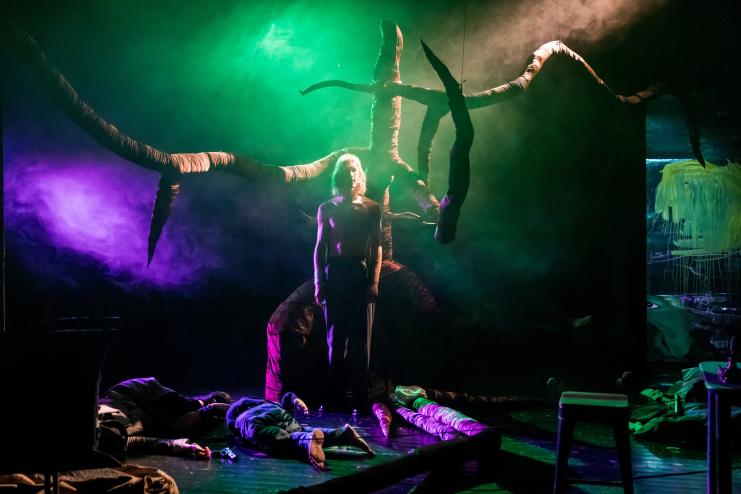Scenography

The scenography department explores both the practical and theoretical aspects of performing arts, exhibitions, cinema and events, with professionals and outside partners who work in those fields. Students are specifically encouraged to set up collaborative and multidisciplinary projects which connect the other departments of the school.
Historical Summary
In 1946, the École des Arts Décoratifs became the first art school in France to provide a stage design course. However, the Scenography Department was created in 1969 by Jacques Le Marquet, Jean Vilar’s scenographer. He introduced a comprehensive understanding of the discipline which has been furthered and developed ever since. In 1991, scenographer and production designer Guy-Claude François took over from him as coordinator of the Scenography Department.
Although the discipline is taught in other schools in France, the École des Arts Décoratifs’s approach stands out as it evenly tackles the various spaces where the discipline is practiced: stages, cinemas, museums, urban spaces… Nowadays, classes within the department are structured around collegiality, interdisciplinarity and horizontality. Multidisciplinarity, openness and cooperation are essential for any scenographer. Those qualities are fostered by the workshop managers’ technical skills and those of the other professions involved in scenography.
Teaching
Scenography is an art of representation and of the ephemeral. It explores every possibility and every form of expression which are gathered to convey the theatrical tension created between space and storytelling, space and language. As scenography is a mode of representation, it displays a worldview.
Students learn how to transform an idea into a concrete production, using conceptual and aesthetic thinking. This process involves choosing materials and forms as well as understanding the project’s constraints.
Students tackle the various fields of creation—performing arts, cinema, exhibitions, public space, events—create small-scale and full-scale productions, collaborate with external partners and complete various internships before carrying out their Grand Projet in year 5.
The last year of the Master’s degree enables students to perfect a scenography project in their field of choice. The latter is based on a topic or text they have chosen and often follows on from their research thesis.
Since 2019, eco-design methods have fundamentally been incorporated in the department courses, which increasingly consider the environmental crisis we are facing.
Bachelor’s Degree
Year 2 revolves around the basics. The scenography courses should accustom students to the wide range of scenography techniques. Students are introduced to models, lights, sound, digital spaces, materials, morphostructure and perspective. In that year, they especially learn to design a show’s scenography using models and to use Autocad and SketchUP, technical drawing and 3D modeling software. The basics also include theoretical classes on the history of Occidental contemporary scenography and of scenic forms.
In year 3, students are faced with both the technical and conceptual challenges of scenography. Indeed, they bring their project to life through a group creation in the first semester—workshop “Atelier des espaces filmiques”—and an individual one in the second semester—workshop “Évènements spectaculaires”—at the Théâtre de l’Aquarium in Paris. Each student is given the chance to use the theater’s outdoor or indoor space as a space of dynamic representation and creation. Those two projects are the focus of the year, along with the development of technical scenography skills.
Master’s Degree
Year 4. Most students study abroad during the first semester. Those who stay in Paris study at the School and spend the semester with fourth-year transfer students and Erasmus students. They each keep in touch with their thesis advisor and are all reunited in the second semester. Each semester, students are offered a partnership project. The aim is to challenge them, as they will create a scenography production in a professional setting, thus letting them be independent in their creation process, as they work with various third parties. They are offered exhibition design projects by partnerships with the Cité de l’Architecture and the Centre Pompidou-Paris. Set design projects are offered by partnerships with other schools, such as the Conservatoire national supérieur d’art dramatique and the École supérieure d’art dramatique de Paris.
Year 5. In their last year, students learn to work independently, manage their time and create their own work methodology, while asserting their unique aesthetics.
Each student develops a personal project, the topic and form of which they choose. The creation can be a model or a full-scale production which may be done individually or with a student from another department. Various contributors must be included so that the project can be brought to fruition. The final project evaluation will also greatly be based on the quality of the research, experimentation and work processes. Besides the model, the technical drawings and the research, each student shall create a personal, new and committed project.
Teachers
| Nom | Fonction |
|---|
Mémoires
| Étudiant.e.s | Titre du Projet | Année |
|---|